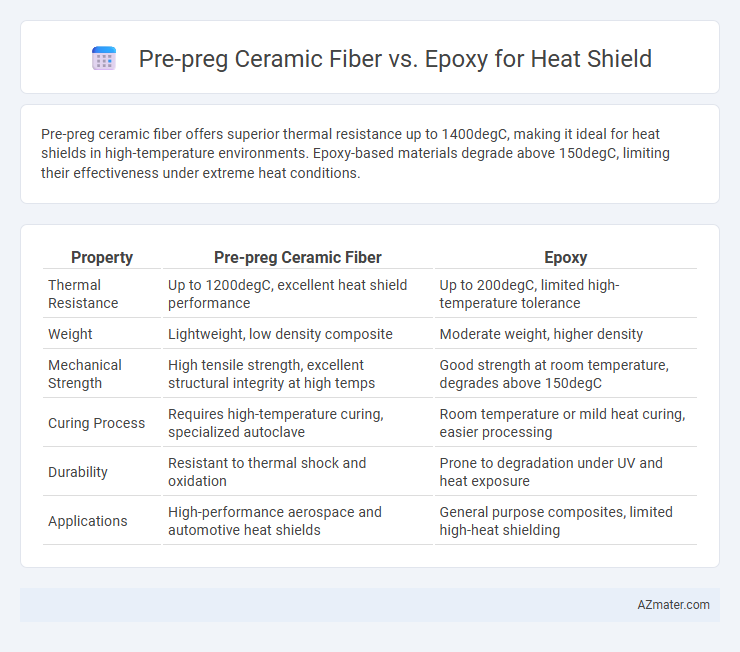Pre-preg ceramic fiber offers superior thermal resistance up to 1400degC, making it ideal for heat shields in high-temperature environments. Epoxy-based materials degrade above 150degC, limiting their effectiveness under extreme heat conditions.
Table of Comparison
| Property | Pre-preg Ceramic Fiber | Epoxy |
|---|---|---|
| Thermal Resistance | Up to 1200degC, excellent heat shield performance | Up to 200degC, limited high-temperature tolerance |
| Weight | Lightweight, low density composite | Moderate weight, higher density |
| Mechanical Strength | High tensile strength, excellent structural integrity at high temps | Good strength at room temperature, degrades above 150degC |
| Curing Process | Requires high-temperature curing, specialized autoclave | Room temperature or mild heat curing, easier processing |
| Durability | Resistant to thermal shock and oxidation | Prone to degradation under UV and heat exposure |
| Applications | High-performance aerospace and automotive heat shields | General purpose composites, limited high-heat shielding |
Introduction to Heat Shield Materials
Heat shield materials such as pre-preg ceramic fiber and epoxy play critical roles in thermal protection systems, with pre-preg ceramic fibers offering superior heat resistance up to 1600degC, making them ideal for aerospace and industrial applications. Epoxy-based heat shields provide excellent structural integrity and adhesion but typically withstand temperatures only up to 200degC to 300degC, limiting their use in extreme thermal environments. Understanding the thermal conductivity, mechanical strength, and maximum operating temperatures of these materials is essential for selecting the appropriate heat shield solution.
Overview of Pre-preg Ceramic Fiber
Pre-preg ceramic fiber is a high-performance material designed for extreme temperature resistance, commonly used in aerospace and automotive heat shields. It consists of ceramic fibers pre-impregnated with a resin or binder, providing superior thermal stability and lightweight properties compared to epoxy-based composites. This material excels in insulating against temperatures exceeding 1000degC, making it ideal for applications requiring efficient heat protection and durability under harsh conditions.
Overview of Epoxy-Based Heat Shields
Epoxy-based heat shields offer excellent thermal insulation with high mechanical strength and resistance to chemical degradation, making them suitable for moderate temperature applications up to 150degC. These composites provide superb adhesion and flexibility, enabling effective protection in automotive and aerospace environments where lightweight and durability are critical. Compared to pre-preg ceramic fiber, epoxy heat shields demonstrate faster curing times and easier fabrication but may lack the extreme temperature resistance necessary for high-heat scenarios exceeding 1000degC.
Thermal Resistance Comparison
Pre-preg ceramic fiber heat shields exhibit superior thermal resistance, maintaining stability at temperatures exceeding 1,200degC (2,192degF), compared to epoxy-based shields, which typically degrade above 150degC to 200degC (302degF to 392degF). Ceramic fibers resist thermal shock and maintain structural integrity in extreme heat environments, making them ideal for aerospace and automotive applications requiring high-temperature protection. Epoxy heat shields, while offering good mechanical properties and ease of application, are limited to low-to-moderate temperature uses due to their lower thermal threshold and susceptibility to thermal degradation.
Weight and Structural Differences
Pre-preg ceramic fiber heat shields offer significantly lower weight compared to epoxy-based counterparts due to their high-temperature resistance and lightweight fiber matrix. Structurally, ceramic fiber composites provide superior thermal stability and maintain integrity under extreme heat, whereas epoxy-based materials tend to degrade and lose strength at elevated temperatures. The ceramic fiber's porous, flexible structure contrasts with the denser, more brittle epoxy resin, impacting durability and performance in high-heat applications.
Durability and Longevity
Pre-preg ceramic fiber exhibits superior durability and longevity compared to epoxy when used in heat shields, withstanding extreme temperatures above 1200degC without degradation. Epoxy-based heat shields typically degrade at temperatures exceeding 200degC, limiting their lifespan in high-heat applications. Ceramic fiber's resistance to thermal shock and chemical corrosion ensures prolonged structural integrity in aerospace and automotive heat shield environments.
Ease of Installation and Fabrication
Pre-preg ceramic fiber offers superior ease of installation for heat shields due to its lightweight nature and flexibility, allowing for precise molding and minimal cutting during fabrication. Epoxy-based materials typically require longer curing times and more complex surface preparation, making the fabrication process more labor-intensive and time-consuming. The thermal stability of pre-preg ceramic fiber also reduces the risk of deformation under heat, enhancing durability while simplifying assembly.
Cost Analysis
Pre-preg ceramic fiber heat shields generally offer higher initial costs due to the advanced materials and manufacturing processes involved, while epoxy-based heat shields tend to be less expensive upfront. However, ceramic fiber's superior thermal stability and durability can reduce long-term maintenance and replacement expenses, potentially lowering total lifecycle costs. Evaluating cost-effectiveness requires considering factors like operating temperature ranges, environmental exposure, and expected service life.
Applications in Industry
Pre-preg ceramic fiber heat shields offer superior thermal resistance and durability in high-temperature industrial applications such as aerospace engine insulation and automotive exhaust systems, outperforming epoxy-based alternatives prone to thermal degradation. These ceramic fiber composites maintain structural integrity above 1000degC, making them ideal for gas turbines, furnaces, and industrial ovens where prolonged heat exposure is critical. Epoxy heat shields, limited to temperatures below 200degC, are better suited for electronics or low-heat machinery but lack the robust protection required in heavy industrial heat management.
Conclusion: Choosing the Best Heat Shield Material
Pre-preg ceramic fiber offers superior thermal resistance, withstanding temperatures above 1,200degC, making it ideal for extreme heat shield applications. Epoxy heat shields provide excellent mechanical strength and chemical resistance but have a lower thermal limit, generally below 200degC. Selecting the best heat shield material depends on the specific temperature requirements and environmental conditions, with pre-preg ceramic fiber favored for high-temperature environments and epoxy suited for moderate heat and structural durability.

Infographic: Pre-preg Ceramic Fiber vs Epoxy for Heat Shield
 azmater.com
azmater.com